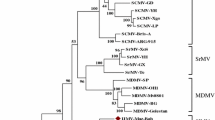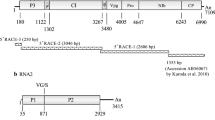Summary
Vanilla necrosis potyvirus (VNV) is the cause of significant losses to the South Pacific islands vanilla crop. The gene for the coat protein of VNV has been cloned and sequenced. Comparison of this gene with other potyviral coat protein sequences revealed 97% nucleotide sequence homology (98% amino acid homology) to a US isolate of watermelon mosaic virus II (WMV-II), 93% nucleotide sequence homology (96% amino acid homology) to an Australian isolate of WMV-II and 81% nucleotide sequence homology (88% amino acid homology) to soybean mosaic virus-N (SMV-N). Serological analysis, by Western blot and ELISA, confirmed the close relationship between VNV and WMV-II. Furthermore, a limited host range determination found VNV and WMV-II able to infect the same series of test plants. However, symptoms differed significantly on three test species demonstrating that VNV and WMV-II are not identical in biological properties. We suggest that VNV be renamed WMV-II (Tonga).
Similar content being viewed by others
References
Allison RF, Dougherty EG, Parks TD, Willis L, Johnston RE, Kelly ME, Armstrong FB (1985) Biochemical analysis of capsid protein gene and capsid protein of tobacco etch virus: N-terminal amino acids are located on the virion's surface. Virology 147: 309–316
Allison R, Johnston RE, Dougherty WG (1986) The nucleotide sequence of the coding region of tobacco etch virus genomic RNA: evidence for the synthesis of a single polyprotein. Virology 154: 9–20
Batteiger B, Newhall V WJ, Jones RB (1982) The use of Tween 20 as a blocking agent in the immunological detection of proteins transferred to nitrocellulose membranes. J Immunol Methods 55: 297–307
Bryan GT, Gardner RC, Forster RLS (1992) Nucleotide sequence of the coat protein gene of a strain of clover yellow vein virus from New Zealand: conservation of a stemloop structure in the 3′ region of potyviruses. Arch Virol 124: 133–146
Carrington JC, Dougherty WG (1988) A viral cleavage site cassette: identification of amino acid sequences required for tobacco etch virus polyprotein processing. Proc Natl Acad Sci USA 85: 3391–3395
Devereux J, Haeberli P, Smithies O (1984) A comprehensive set of sequence analysis programs for the VAX. Nucleic Acids Res 12: 387–395
Domier LL, Franklin KM, Shahabuddin M, Hellmann GM, Overmeyer JH, Hiremath ST, Siaw MEE, Lomonossoff GP, Shaw JG, Rhoads E (1986) The nucleotide sequence of tobacco vein mottling virus RNA. Nucleic Acids Res 14: 5417–5430
Dougherty WG, Carrington JC (1988) Expression and function of potyviral gene products. Annu Rev Phytopathol 26: 123–143
Eagles RM, Gardner RC, Forster RLS (1991) Nucleotide sequence of the tamarillo mosaic virus coat protein gene. Nucleic Acids Res 18: 7166
Eggenberger AL, Stark DM, Beachy RN (1989) The nucleotide sequence of a soybean mosaic virus coat protein-coding region and its expression inEscherichia coli, Agro-bacterium tumefaciens and tobacco callus. J Gen Virol 70: 1853–1860
Frenkel MJ, Ward CW, Shukla DD (1989) The use of 3′ non-coding nucleotide sequences in the taxonomy of potyviruses: application to watermelon mosaic virus 2 and soybean mosaic virus-N. J Gen Virol 70: 2775–2783
Gibson RW (1988) Advantages of a soluble dye in blot immunobinding assays for virus detection in potatoes. Potato Res 31: 389–394
Gubler U, Hoffman BJ (1983) A simple and very efficient method for generating cDNA libraries. Gene 25: 263–269
Hawkes R, Niday E, Gordon J (1982) A dot-immunobinding assay for monoclonal and other antibodies. Anal Biochem 119: 142–147
Hill AS (1984) Methods in plant virology. Blackwell, Oxford
Maiss E, Timpe U, Brisske A, Jelkmann W, Casper R, Himmler G, Mattanovich D, Katinger HWD (1989) The complete nucleotide sequence of plum pox virus RNA. J Gen Virol 70: 513–524
Pearson MN, Pone SP (1988) Viruses of vanilla in the Kingdom of Tonga. Aust Plant Pathol 17: 59–60
Pearson MN, Brunt AA, Pone SP (1990) Some hosts and properties of a potyvirus infectingVanilla fragrans (Orchidaceae) in the Kingdom of Tonga. J Phytopathol 128: 46–54
Pone SP (1989) An investigation of three virus diseases ofVanilla fragrans (Salisb.) Ames in the Kingdom of Tonga. MSc thesis, University of Auckland, New Zealand
Purseglove JW, Brown EG, Green CL, Robbins SRJ (1988) Spices, 2nd edn. Longman, Singapore
Quemada H, Sieu LC, Siemieniak DR, Gonsalves D, Slightom JL (1990) Watermelon mosaic virus II and zucchini yellow mosaic virus: cloning of 3′-terminal regions, nucleotide sequences, and phylogenetic comparisons. J Gen Virol 71: 1451–1460
Reddick BB, Barnett OW (1983) A comparison of three potyviruses by direct hybridization analysis. Phytopathology 73: 1506–1510
Sambrook J, Fritsch EF, Maniatis T (1989) Molecular cloning. A laboratory manual, 2nd edn. Cold Spring Harbor Laboratory, NY
Shukla DD, Ward CW (1988) Amino acid sequence homology of coat proteins as a basis for identification and classification of the potyvirus group. J Gen Virol 69: 2703–2710
Shukla DD, Ward CW (1989) Identification and classification of potyviruses on the basis of coat protein sequence data and serology. Arch Virol 106: 171–200
Shukla DD, Gough KH, Ward CW (1987) Coat protein of potyviruses. 3. Comparison of amino acid sequences of the coat proteins of four Australian strains of sugarcane mosaic virus. Arch Virol 96: 59–74
Shukla DD, McKern NM, Ward CW (1988) Coat protein of potyviruses 5. Symptomatology, serology, and coat protein sequences of three strains of passionfruit woodiness virus. Arch Virol 102: 221–232
Towbin H, Staehelin T, Gordon J (1979) Electrophoretic transfer of proteins from polyacrylamide gels to nitrocellulose sheets: procedure and some applications. Proc Natl Acad Sci USA 76: 4350–4354
Turpen T (1989) Molecular cloning of a potato virus Y genome: nucleotide sequence homology in non-coding regions of potyviruses. J Gen Virol 70: 1951–1960
Wisler GC, Zettler FW, Mu L (1987) Virus infections of vanilla and other orchids in French Polynesia. Plant Dis 71: 1125–1129
Xu Z, Barnett OW, Gibson PB (1986) Characterization of peanut stunt virus strains by host reactions, serology, and RNA patterns. Phytopathology 76: 390–395
Yu HM, Frenkel MJ, McKern NM, Shukla DD, Strike PM, Ward CW (1989) Coat protein of potyviruses 6. Amino acid sequences suggest watermelon mosaic virus 2 and soybean mosaic virus-N are strains of the same potyvirus. Arch Virol 105: 55–64
Author information
Authors and Affiliations
Rights and permissions
About this article
Cite this article
Wang, Y.Y., Beck, D.L., Gardner, R.C. et al. Nucleotide sequence, serology and symptomatology suggest that vanilla necrosis potyvirus is a strain of watermelon mosaic virus II. Archives of Virology 129, 93–103 (1993). https://doi.org/10.1007/BF01316887
Received:
Accepted:
Issue Date:
DOI: https://doi.org/10.1007/BF01316887




